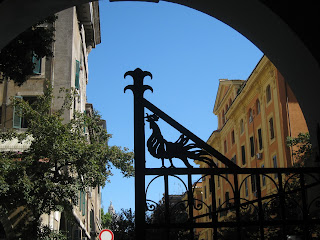 |
| A Courtyard in one of Trionfale's Fascist-Era Public Housing Projects |
Rome the Second Time is partly a book about Rome's suburbs. But that doesn't mean we're sending you to Rome's equivalent of Westchester. Our Rome suburbs are outside the Center, to be sure, so they weren't built in the Renaissance. But they are close to the Center, and they feel like Rome: today's Rome, and the Rome of the 20th century.
Some time ago we spent the afternoon in the Rome suburb of Trionfale (Triumphant/Triumphal, the name apparently derived from the city's historic attraction to triumphal arches). Romans would refer to the area as Trionfale or Quartiere Trionfale. It's in Prati.
We can't give you a precise geographical definition for Trionfale. But the center of the quartiere is just to the east of Piazzale degli Eroi ("Large Piazza of the Heroes" - a pretty awful traffic circle, says Dianne), along and a few blocks north and south of via Andrea Doria, which runs into the piazza.
If you're staying near the Vatican, you're in luck, because Trionfale begins just a few blocks north of the north wall of the Vatican. If you're taking the subway, get off at Cipro Musei Vaticani and walk north to Piazza degli Eroi.
 |
| Cinema Doria |
Standing in Piazza degli Eroi and looking toward the northeast, in front of you is one of the quartiere's finest pieces of architecture: a massive public housing project that spans the pre-Fascist and Fascist (1922- ) eras. Constructed for the ICP (Istituto Case Popolari/Institute for Public Housing), it was designed by architects Innocenzo Costantini and Innocenzo Sabbatini and built between 1919 and 1926. The building combines modern elements with medieval ornamentation; the gargoyles are impressive. You'll have to take our word for all this because, remarkably, we don't have a photo to show you. On the via Andrea Dorea side you'll find a movie theater, the Cinema Doria, richly decorated though now in a degraded state.

Just to the east and north is a complex of public housing buildings with a variety of architectural features, including ornate iron work, glass-enclosed stairways, and--especially--public spaces designed to shelter the residents of the buildings from the chaos and dangers of the street and to provide a common exterior space where residents of the undoubtedly small (and balcony-less) apartments could sit in the open area and meet their neighbors. We recommend a leisurely stroll through these areas. See photo at top.
 |
| Casa Impiegati del Governatorato |
Across via A. Doria and about three blocks east at via A. Doria 1-27 is a thoughtfully designed, late-1920s building by one of Rome's best-known architects, Mario De Renzi. Its formal name is the Casa Impiegati del Governatorato--literally House of Governership Employees. It's three wings allow for lots of natural light. Perhaps the most interesting feature are the rounded windows, especially on the side on the second floor but also running up the front, referencing similar forms that had recently (at the time) been excavated at ancient Roman port of Ostia Antica. Nearby, on the same side of the street, is another building with medieval touches.
 |
| The new Trionfale Market--or the Hyatt? |
Our last stop is the Trionfale Market, not far to the east on via A. Doria. Rome planners have been busy in recent years replacing the city's older markets with new ones that are better lit, more sanitary, and perhaps better organized (
see Bill's earlier post on this push by the city government). But in this case we're not fans of progress. The new market is too big and too impersonal and designed in a derivative, post-modern style that lacks character and fails to find peace with the surrounding community. We don't know what the neighborhood's residents think, but only 91 people have signed up for the market's Facebook page.
Bill
Title:
Trionfale: A Rome "Suburb"
Rating:
100%
based on
99998 ratings.
5 user reviews.
Author
Unknown
1:33 AM
Related Articles Cinema Doria, Fascism, ICP, Mario De Renzi, markets, public housing, Trionfale, Vatican, via Andrea Doria :











